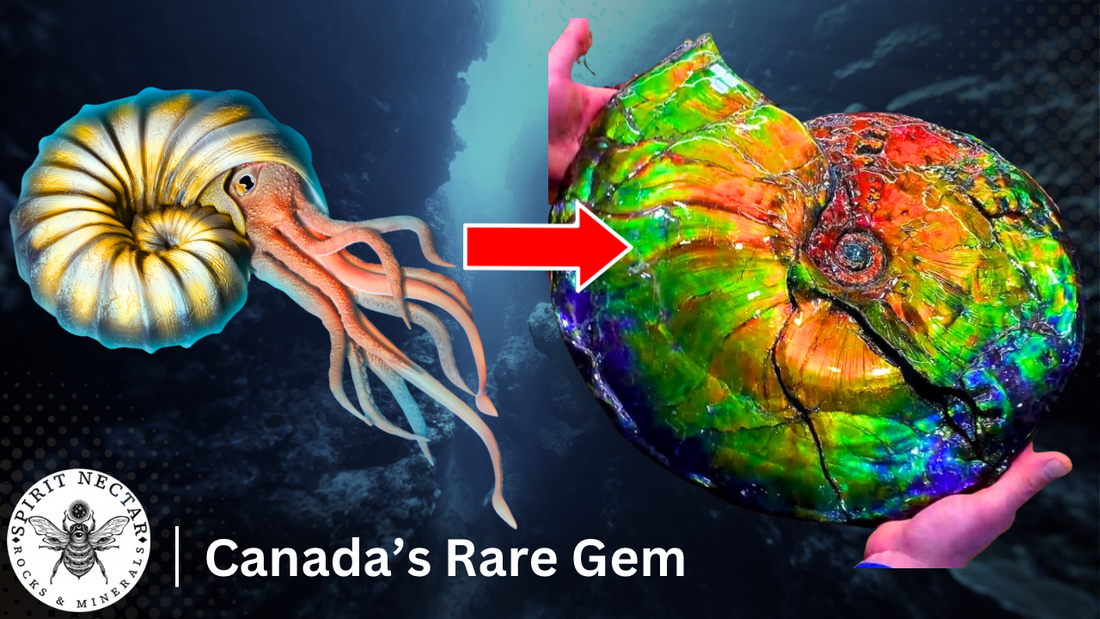
Ammolite Explained: What makes one of the rarest gems so special?
Share
When you think of world-class gems, Canada is probably one of the last places most people are going to consider. However, there is one mesmerizing gem that can almost exclusively be found in Canada. Pictured below is the rare, and incredibly expensive natural material known as ammolite.

Ammolite is all the remains of a long extinct marine mollusk that lived about 75 million years ago. This organism is called "ammonite", named after the ancient Egyptian god Amun. They were relatives of modern squids, octopuses, and cuttlefish. Ammonites are particularly known for their distinctive spiral shaped shells, which are divided into chambers separated by thin walls.

The mollusk lived in the outermost chamber, and used the inner chambers, which were filled with gas or fluid, to control buoyancy. Sizes ranged from a few centimetres to over 2 metres in diameter, depending on the species. Ammonites were likely carnivorous, feeding on small marine animals like plankton, crustaceans, and possibly other small cephalopods.

Ammonite fossils can be found all over the world, but ammolite can only be found in one very specific area of North America, called the Bear Paw Formation. It is primarily exposed in parts of Southern Alberta and Saskatchewan in Canada, and in northern Montana in the United States. The formation dates back to the late cretaceous period, during a time when much of the area was submerged under a vast inland sea. The specimens found in this region, are the only ones with a layer of iridescence thick and vibrant enough to be cut into gemstones.
The fossilized shell is comprised primarily of the mineral aragonite, but the layer with iridescent effect is only about 1/2 of a millimetre thick. This makes it an exceptionally difficult gem to polish, and most specimens and jewelry cabochons are capped with either resin or glass. The value of ammolite depends on its color intensity, rarity, and quality. Blue and purple stones command the highest prices due to their scarcity.

Ammolite was officially recognized as a gemstone in 2004, making it a relatively new contender in the world of precious gems. It is one of only a few biogenic gemstones, along with pearls and amber. It does however, have a much longer history of being treasured by the aboriginal Blackfoot peoples.
They called the material "iniskim", which means buffalo stone. It was used as a talisman to bring good luck. This belief is based around a traditional story, where a woman heard the stone singing to her. It was a particularly harsh winter, and her tribe had run out of food to survive. The stones sang to her with instructions of how to perform a ceremony, that would bring the buffalo back to her people to save them from starvation.

These days, you could get in a lot of legal trouble if you try to sell ammolite shell outside of Canada. That's because ammolite is under the Historical Resources Act, which means you're not even allowed to collect it from the surface, without explicit permission from the government. Rightfully so, First Nations people are exempt from this law. There are very few legally operating mines for ammolite, so prices for this gemstone have remained relatively high. Museum quality pieces can easily go into the hundreds of thousands of dollars.

So what is it, aside from being rare, that makes ammolite so special? The secret lies in its fascinating display of iridescence. Most other gems get their color from light absorption, but ammolite gets its color due to light interference within its mineral microstructure. The light rebounds from stacked layers of thin platelets that make up the aragonite portion of ammolite. Light penetrates some of these layers, and is diffracted in different directions by other layers. This creates the multicolored effect that we see.

The absolute highest grade of gem quality ammolite is found in Southern Alberta, primarily along the Old Man, and Saint Mary rivers. It's an area thats also known for having an enormous amount of dinosaur fossils. Artisanal miners will often scale the cliff sides of the river banks to find ammolites. It's gruelling work, with the hot summer temperatures and open exposure, but the price tags that ammolite can fetch are well worth the effort.
